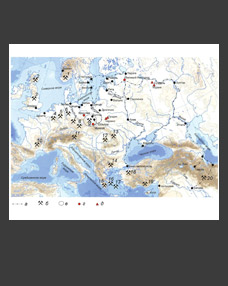Victor A. Trifonov*, Natalia I. Shishlina**, Pavel I. Kalinin***, Andrei O. Alekseev***, Evgenii S. Bogomolov****
* RAS Institute for History of Material Culture, St. Petersburg (viktor_trifonov@mail.ru)
** State Historical Museum, Moscow (nshishlina@mail.ru)
*** RAS Institute of Physical, Chemical and Biological Issues of Soil Studies, Puschino (kalinin331@rambler.ru; alekseev@issp.serpukhov.su)
**** RAS Institute of Pre-Cambrian Geology and Geochronology, St. Petersburg (e.bogomolov@mail.ru)
Key words: red pigments, ochre, cinnabar, sources, production, exchange, burials, dolmens, Bronze Age, Northern Caucasus, Eastern European Steppe.
The paper presents comprehensive analysis of red pigments from dolmens discovered near Stanitsa Tsarskaya in 1898 (modern Novosvobodnaya), the study of dolmens was resumed in 2013. The red pigment samples are represented by two varieties, i.e. ferrous ochre from the ceiling in the burial chamber roofing in kurgan 1, and cinnabar that covered the skeleton of a dead person and funeral goods in the dolmen under kurgan 2. Ochre specimens from two Bronze Age graves uncovered in the same region were analyzed for comparative purposes. To test the methodology for identifying the sources of raw material, a local sample of iron clay and three samples from regional mercury deposits were subjected to analysis. Main characteristics of raw material heating during the production of ochre from the goethites and hematites have been determined. Through the comparison of the lead isotope ratios in pigment samples and mercury ore deposits the source of cinnabar was identified.







